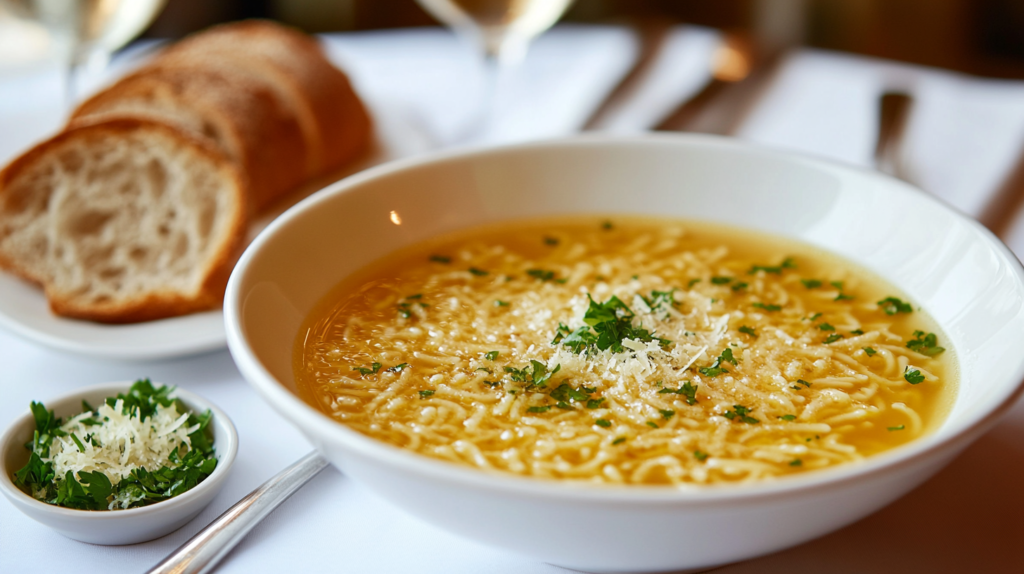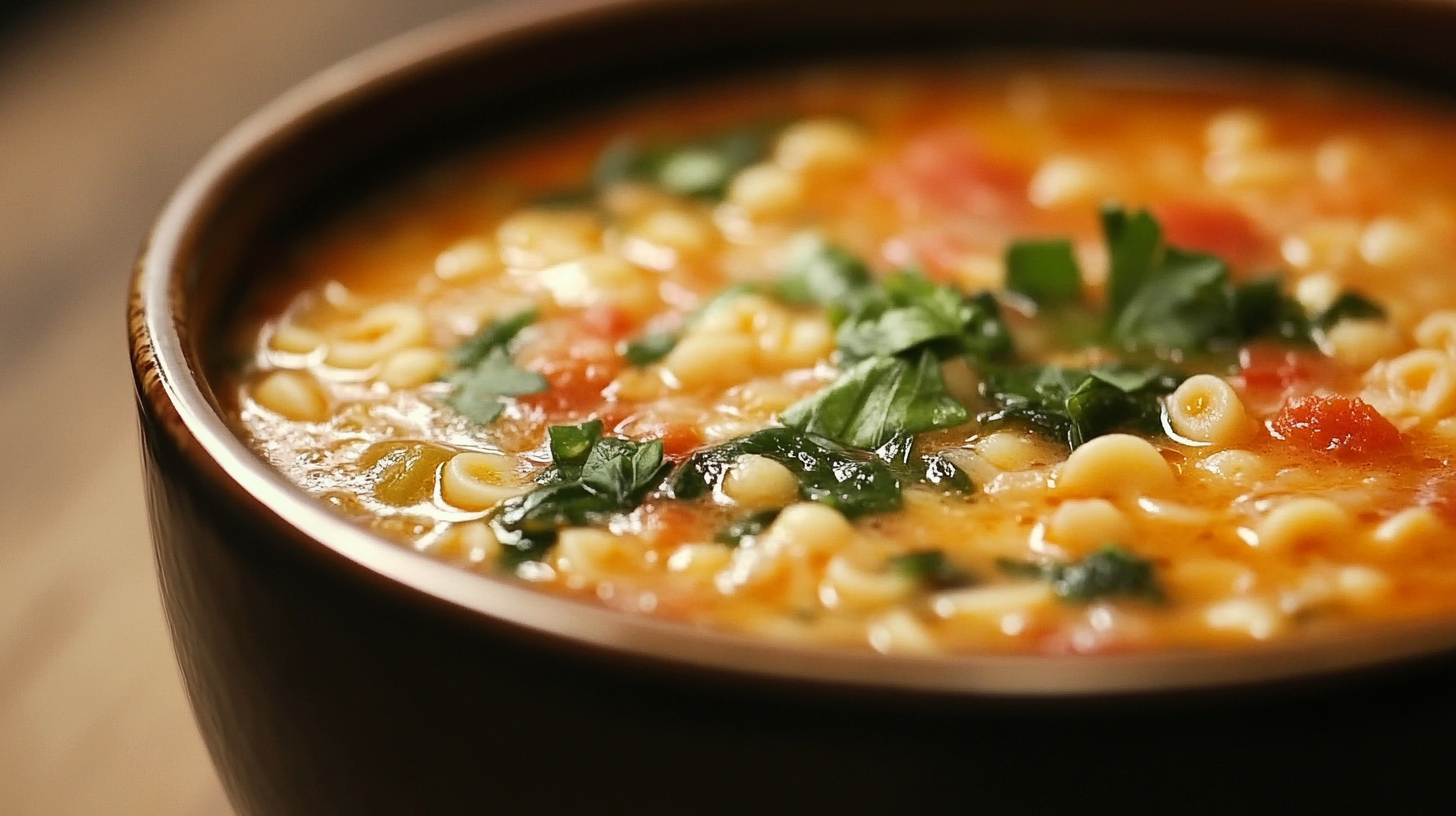There is something undeniably soothing about a warm bowl of pastina soup. Whether you grew up with this classic Italian comfort food or you are discovering it for the first time, pastina soup is the ultimate dish for cozy, nourishing meals.
It is simple, made with tiny pasta, flavorful broth, and a few wholesome ingredients. Yet, despite its simplicity, this dish holds a special place in many kitchens. If you are feeling under the weather, need a quick meal, or just want a taste of home, pastina soup is the answer.
In this guide, we will cover everything you need to know—from the history of pastina soup to a step-by-step recipe, delicious variations, and common mistakes to avoid. Let’s dive into the comforting world of pastina soup.
What is Pastina Soup? A Traditional Italian Comfort Food
Pastina soup is a simple yet heartwarming Italian dish made with tiny star-shaped pasta cooked in broth. The word pastina literally means “little pasta” in Italian, and it refers to the smallest type of pasta available.
The History and Cultural Significance of Pastina Soup
Pastina soup has been a staple in Italian kitchens for generations. Italian families often make it for young children, the elderly, or anyone in need of a comforting meal. It is sometimes called “Italian penicillin” because of its reputation for making people feel better when they are sick.
Traditionally, grandmothers and mothers prepared pastina soup with homemade broth, a little butter, and grated parmesan. Over time, different variations have emerged, each one adding a unique twist while preserving the dish’s simplicity and warmth.
“Pastina soup is more than just food; it’s a memory, a warm hug in a bowl, and a reminder of home.”
Why Pastina Soup is the Perfect Comfort Food
What makes pastina soup so comforting?
- Simple Ingredients – You only need a few pantry staples to make it.
- Quick and Easy to Make – Ready in 15–20 minutes, perfect for busy days.
- Warm and Nourishing – Ideal for cold weather or when you are feeling unwell.
- Customizable – Add different ingredients to suit your taste and dietary needs.
Variations of Pastina Soup Across Italy
While the basic recipe remains the same, different regions in Italy have their own variations of pastina soup.
- Classic Butter & Parmesan Pastina Soup – The simplest version, made with pastina, butter, and parmesan.
- Pastina with Egg (Stracciatella Style) – Whisked eggs are stirred into the soup, creating delicate ribbons of egg for extra protein.
- Chicken Pastina Soup – A heartier variation with shredded chicken for added flavor and nutrition.
- Creamy Milk-Based Pastina Soup – Instead of broth, some families use warm milk for a richer, creamier texture.
Each variation is delicious in its own way, and you can mix and match ingredients to create your perfect bowl.

Essential Ingredients for an Authentic Pastina Soup Recipe
To make the best pastina soup, you need to start with high-quality ingredients. Even though the dish is simple, each component plays a role in creating a rich, comforting flavor.
Choosing the Right Type of Pastina Pasta
Pastina comes in different shapes, and while they all work, some are more traditional than others.
- Stelline (Tiny Stars) – The classic choice, especially for kids.
- Acini di Pepe (Tiny Round Pasta) – Creates a slightly different texture.
- Orzo or Ditalini – Slightly larger, but still small enough for a comforting soup.
Pro Tip: If you cannot find pastina, you can break spaghetti into tiny pieces as a substitute.
Best Broth Options: Homemade vs. Store-Bought
The broth is the heart of the soup, so choosing the right one makes all the difference.
- Homemade Chicken or Vegetable Broth – Rich, deep flavor with no preservatives.
- Store-Bought Broth – A great shortcut if you are short on time.
- Water with Bouillon Cubes – A simple alternative that still adds good flavor.
Pro Tip: For an even richer taste, let the broth simmer with garlic, bay leaves, or fresh herbs before adding the pasta.
Additional Ingredients to Enhance Flavor and Nutrition
Want to add more depth to your pastina soup? Here are some great additions:
- Butter – Adds a silky texture and enhances flavor.
- Parmesan Cheese – Provides a nutty, salty richness.
- Egg – Makes the soup heartier and protein-packed.
- Lemon Juice – A small squeeze adds a refreshing brightness.
- Garlic & Onions – For extra depth in the broth.
Each ingredient brings something special to the table, making your pastina soup even more delicious and nourishing.
Optional Add-Ins for Different Flavor Profiles
If you want to experiment with flavors, here are some creative ways to elevate your pastina soup:
- Fresh Herbs (Parsley, Thyme, Basil) – For added freshness.
- Diced Carrots & Celery – Boosts nutrition and adds texture.
- Shredded Chicken or Turkey – Transforms it into a heartier meal.
- Tomato Paste or Pureed Tomatoes – Creates a richer, slightly tangy broth.
“A simple bowl of pastina soup can be customized in endless ways. The key is to find what brings you comfort.”
Step-by-Step Guide to Making Classic Pastina Soup
Now that we have covered the essential ingredients, let’s walk through the step-by-step process of making classic pastina soup. Whether you are making it for yourself, your family, or someone who needs a little extra comfort, this recipe is quick, simple, and full of warmth.
How to Cook Pastina to the Perfect Texture
Pastina is delicate and cooks much faster than regular pasta. If overcooked, it can become mushy. Here’s how to get the perfect consistency:
- Bring the broth to a boil – Use chicken, vegetable, or beef broth for the best flavor.
- Add the pastina – Stir immediately to prevent clumping.
- Cook for 3–5 minutes – Unlike traditional pasta, pastina softens quickly.
- Remove from heat before fully cooked – It will continue absorbing liquid, so leave it slightly undercooked.
Pro Tip: If you prefer a soupier consistency, add extra broth. If you want itthicker, let the pasta absorb more liquid.
The Best Way to Prepare a Flavorful Broth
The broth is the heart of the soup, so preparing it properly is key to enhancing flavor.
- If using homemade broth, let it simmer for 20–30 minutes with garlic, onions, and fresh herbs.
- If using store-bought broth, enhance the flavor by adding a splash of olive oil, a pinch of salt, and a parmesan rind.
- Strain out any solids if you prefer a smooth broth.
A well-seasoned broth will give the soup depth and warmth, making it far more satisfying.
“A great broth turns a simple dish into something truly special.”
Combining Ingredients for a Creamy and Satisfying Soup
Once the pastina is cooked and the broth is flavored, it’s time to assemble the soup.
- Remove from heat and stir in butter for extra creaminess.
- Add grated parmesan cheese for a salty, nutty richness.
- Season with salt, black pepper, or a squeeze of lemon juice for balance.
- Let the soup sit for a minute to allow the flavors to meld.
At this stage, the soup is ready to enjoy, but if you want to elevate the flavors, try adding some of the variations below.
Tips for Achieving the Perfect Consistency
Some like their pastina soup thick, while others prefer it brothy. Here’s how to get the texture just right:
a thicker soup, let the pastina absorb more broth or stir in a whisked egg for added creaminess.
For a lighter consistency, add more broth or a splash of warm milk.
For a velvety texture, blend a small portion of the soup and mix it back in.
Delicious Variations of Pastina Soup

Classic pastina soup is delicious on its own, but you can easily customize it to match your preferences. Here are some of the best variations to try.
Traditional Pastina Soup with Butter and Parmesan
This is the simplest version of pastina soup—buttery, creamy, and full of flavor.
How to Make It:
- Cook pastina in chicken broth until just tender.
- Remove from heat and stir in one tablespoon of butter.
- Mix in grated parmesan cheese until fully melted.
- Season with salt and black pepper.
Why You’ll Love It:
- Rich and creamy without being too heavy.
- Quick to make with only a few ingredients.
Pastina Soup with Egg (Italian Stracciatella Style)
This variation is inspired by Stracciatella, an Italian egg drop soup, making it more filling and protein-packed.
How to Make It:
- Follow the basic pastina soup recipe.
- In a small bowl, whisk one egg with a tablespoon of parmesan.
- Slowly pour the egg mixture into the soup while stirring to create ribbons of egg.
- Let the egg cook for 1–2 minutes before serving.
Why You’ll Love It:
- Silky and comforting with a delicate egg texture.
- Great for extra protein without adding meat.
Chicken Pastina Soup for Added Protein and Comfort
Adding shredded chicken turns this simple soup into a complete meal.
How to Make It:
- Cook pastina in chicken broth as usual.
- Add shredded cooked chicken (leftover roast chicken works great).
- Stir in chopped carrots and celery for extra nutrients.
- Let everything simmer for a few minutes before serving.
Why You’ll Love It:
- Hearty and filling, perfect for a full meal.
- Great for boosting immunity with protein and vegetables.
Creamy Pastina Soup with Milk and Cheese
For a richer, silkier texture, this variation uses milk instead of broth.
How to Make It:
- Heat a combination of milk and water (or broth).
- Cook the pastina in the liquid, stirring frequently.
- Add butter and shredded mozzarella or parmesan for creaminess.
- Stir until smooth and creamy.
Why You’ll Love It:
- Ultra-creamy and indulgent, almost like an Italian mac and cheese.
- Great for kids who love cheesy pasta dishes.
Vegetarian and Vegan-Friendly Pastina Soup
For a plant-based version, swap out dairy and animal-based ingredients for alternatives.
How to Make It:
- Use vegetable broth instead of chicken broth.
- Replace butter with olive oil or dairy-free margarine.
- Add finely chopped spinach or kale for extra nutrition.
- Top with nutritional yeast instead of parmesan for a cheesy flavor.
Why You’ll Love It:
- Still rich and flavorful without animal products.
- Packed with vitamins and fiber from added greens.
Common Mistakes When Making Pastina Soup (and How to Fix Them)
Even though pastina soup is simple, a few common mistakes can affect the texture and flavor.
Why Did My Pastina Absorb Too Much Broth?
- Cause: Pastina is highly absorbent and continues soaking up liquid after cooking.
- Solution: Add extra broth before serving or cook pastina separately and mix it in at the last minute.
How to Prevent Pastina from Becoming Mushy
- Cause: Overcooking or leaving the pastina in hot liquid too long.
- Solution: Cook until just tender, then remove from heat immediately.
How to Adjust Seasoning for a Balanced Flavor
- Cause: Store-bought broth can be too salty, or the soup may lack depth.
- Solution: Taste before adding salt and enhance flavor with fresh herbs, lemon juice, or a parmesan rind.
What to Do If the Soup is Too Thick or Too Thin
- If too thick: Add extra broth to loosen it up.
- If too thin: Let it simmer for a few minutes longer or stir in a small amount of flour or cheese.
Storing and Reheating Pastina Soup Without Losing Texture

Pastina soup is best enjoyed fresh, but if you have leftovers, proper storage and reheating can help preserve its flavor and texture. Since pastina is highly absorbent, it can soak up the broth and become too thick when stored. Below are the best methods for keeping your soup delicious and fresh.
How to Properly Store Leftover Pastina Soup
Refrigerator Storage (Up to 3 Days)
If you plan to eat the soup within a few days, store it in the refrigerator.
- Let the soup cool completely before transferring it to a container.
- Store in an airtight container to prevent it from absorbing other flavors.
- Keep the pastina and broth separate if possible to prevent over-absorption.
Freezer Storage (Up to 2 Months)
Freezing pastina soup can be tricky since the pasta can become mushy when thawed. Here’s how to store it properly:
- If possible, freeze the broth separately and cook fresh pastina when reheating.
- If freezing the entire soup, portion it into freezer-safe containers.
- Leave room in the container for expansion as the liquid freezes.
- Label with the date and use within two months for the best quality.
“To avoid mushy pasta, always store pastina and broth separately when possible.”
Best Methods to Reheat Pastina Soup Without Overcooking
Reheating pastina soup requires a bit of care to maintain its original texture. Here are the best ways to reheat it:
Stovetop Method (Best for Preserving Texture)
- Pour the soup into a small pot over low to medium heat.
- If the soup is too thick, add extra broth or water to adjust consistency.
- Stir gently and heat for 3–5 minutes until warmed through.
Microwave Method (Quickest Option)
- Place the soup in a microwave-safe bowl.
- Add a splash of broth if it has thickened too much.
- Cover loosely and heat in 30-second intervals, stirring between each.
Reheating Frozen Pastina Soup
- Thaw overnight in the refrigerator for best results.
- Follow the stovetop reheating method, adding extra broth as needed.
If the pastina has absorbed too much liquid and turned mushy, you can fix it by adding fresh-cooked pastina to the soup before serving.
Frequently Asked Questions About Pastina Soup
Still have questions? Here are some of the most common concerns about making, storing, and modifying pastina soup.
Can I Make Pastina Soup Ahead of Time?
Yes, but with a few adjustments. If making pastina soup ahead of time, it’s best to store the broth separately from the cooked pastina to prevent it from getting too thick or mushy.
How to Prep in Advance:
Make the broth ahead of time and store it in the refrigerator or freezer.
Cook the pastina separately when you’re ready to eat, then combine it with the reheated broth.
Can I Use Other Types of Pasta Instead of Pastina?
Yes! If you don’t have pastina, you can substitute other small pasta shapes. Here are some great alternatives:
Orzo – Similar in size but slightly more elongated.
Acini di pepe – Tiny round pasta that holds its texture well.
Ditalini – Small tubes that add a bit more bite.
Broken Spaghetti – A good substitute if no small pasta is available.
Pro Tip: If using a larger pasta, adjust the cooking time to avoid overcooking.
How Do I Make Pastina Soup Creamier Without Dairy?
If you want a creamy consistency without using butter, milk, or cheese, here are some dairy-free options:
Blended Vegetables – Pureeing a portion of the soup thickens it naturally.
Olive Oil – A drizzle adds richness without dairy.
Coconut Milk – Works well for a creamy, slightly sweet taste.
Nutritional Yeast – Gives a cheesy flavor without actual cheese.
“A few simple swaps can make pastina soup creamy while keeping it dairy-free.”
What Can I Serve with Pastina Soup?
Pastina soup is comforting on its own, but pairing it with a side dish can turn it into a more complete meal.
Classic Italian Side Dishes:
Crusty Bread – Perfect for dipping into the broth.
Garlic Bread – Adds a crispy, flavorful contrast.
Bruschetta – Light and fresh, with a hint of acidity.
Healthy and Fresh Pairings:
Simple Green Salad – A fresh contrast to the warm soup.
Roasted Vegetables – Adds more nutrients and texture.
Steamed Asparagus or Broccoli – Light and easy to prepare.
For a heartier meal, consider serving it with grilled chicken, fish, or roasted potatoes.
Discover More Comforting and Delicious Recipes
If you enjoyed this Pastina Soup Recipe, here are more cozy and flavorful dishes to try:
- Looking for more warm and creamy soups? Check out these 7 Must-Try Creamy & Flavorful Soups for Every Occasion for comforting bowl ideas.
- Want another classic and hearty meal? Old-Fashioned Goulash: A Classic Comfort Food Recipe is a rich and satisfying dish perfect for a cozy night in.
- Need a delicious and easy bread pairing for your soup? Cheese & Breadsticks: A Delicious Combo for Every Occasion is a great way to complement your meal.
- Craving a side dish with a touch of sweetness? Try this Easy Sweet Potato Crunch Recipe to Wow Your Guests for a perfect balance of flavors.
- Looking for a refreshing drink to go with your meal? Orange Crush Drink Recipe: A Refreshing Citrus Delight is a light and zesty option.
For more comforting and delicious meal ideas, visit Call Me Recipes and explore new flavors today!
Conclusion: Enjoying the Warmth and Simplicity of Pastina Soup
Pastina soup is more than just a dish—it’s a bowl of comfort, tradition, and nourishment. Whether you’re making it for a sick day, a quick meal, or simply to enjoy its classic taste, this soup delivers warmth in every bite.
Simple to make with minimal ingredients.
Customizable to suit any dietary preference.
Great for meal prep and easy to store.
Now that you have the full guide, try making your own version of pastina soup. Whether you prefer it with chicken, eggs, cheese, or fresh herbs, the possibilities are endless.
“A bowl of pastina soup is like a warm hug—it’s comforting, familiar, and always satisfying.”

